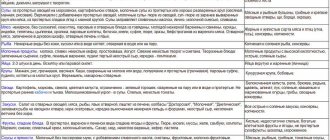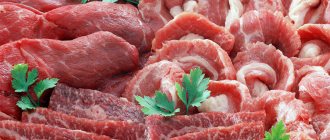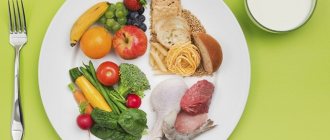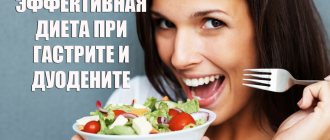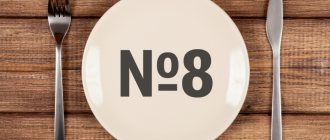General characteristics of dietary table No. 1B
Diet No. 1B fully satisfies a person’s physiological needs for energy and nutrients in a hospital setting. Diet No. 1B provides less severe protection of the stomach from mechanical, chemical and temperature irritation than diet 1A. All dishes are liquid and mushy. Excluded are dishes and products that have a strong effect on the walls and mucous membranes, stimulate secretion, are difficult to digest, hot and cold dishes. Diet No. 1B provides for fractional meals at least 6 times a day, in small portions. Milk is recommended before bed. The main difference between diet 1B and diet 1A is the gradual increase in calorie intake and the proportion of nutrients.
General rules
Medical nutrition is a mandatory component of the treatment of stomach diseases. Table No. 1B of the Pevzner diet is indicated for mild exacerbation of peptic ulcer disease and chronic gastritis in the subsiding stage of the process.
This is a table for less drastic limitation of mechanical, chemical and temperature effects on the stomach. It is prescribed to reduce inflammation, stimulate the healing of ulcers and provide adequate nutrition. A table is prescribed with continued bed and semi-bed rest at the next stages of the patient’s treatment after Diet 1A , since it is more stressful: the content of basic nutrients and calorie content has been increased, new products and dishes prepared using a different technology have been introduced. The amount of protein is increased to 100 g, fat to 100 g and carbohydrates to 300 g (but not the physiological norm).
Protein is replenished through milk proteins (increased amounts of milk, milk porridges and cottage cheese), and not through protein meat dishes. They are still recommended once a day. This is due to the fact that milk protein is considered easily digestible. The amount of liquid you drink is 2 liters. The temperature of hot dishes is 55-60°C, cold food is 15-20°C. The length of time for following this diet varies from person to person – on average it ranges from 10 days to a month.
The main nutritional points are:
- Considering that patients are on bed and semi-bed rest, food is prepared in a mushy and puree form. Dishes are first boiled and then pureed.
- Secretion agents (broths) and irritants (rough foods and some vegetables) are excluded.
- Difficult to digest foods are excluded (mushrooms, tough meat with fascia, tendons and skin, fried foods).
- Meat and fish dishes are served in the form of steam soufflés, quenelles, mashed potatoes, and cutlets.
- Canned vegetables and fruits for baby food are allowed.
- Some vegetables are introduced in the form of puree (potato, carrot, beetroot).
- Excessively hot and cold dishes are excluded, which slow down the regeneration processes of the mucous membrane.
- Calorie content is reduced due to a slight reduction in carbohydrates in the diet.
- The allowed amount of salt is 8-10 g.
- Meals are provided 6 times a day in fractional portions. Eating meals at the same time helps reduce inflammation.
- Milk is recommended at night.
When treating gastritis and peptic ulcers with high acidity, the sequential administration of treatment Tables 1A (6-10 days), 1B (on average up to two weeks) and No. 1 (up to six months) prepares the gastrointestinal tract for the transition to the general table. All treatment tables exclude strong stimulants of gastric secretion and contain dishes that have a weak juice effect: milk, eggs, milk porridge, sweet fruit juices. Therapeutic nutrition creates conditions for eliminating inflammation, a sufficient amount of protein promotes scarring of the ulcer, and frequent meals and consumption of pureed foods cause mechanical sparing of the mucous membrane.
Chemical composition and energy value of dietary table No. 1B
Proteins: 90 g (at least 50% animal proteins). Fats: 80 g (at least 30% vegetable fats). Carbohydrates: 300–350 g (no more than 30 g of simple carbohydrates). Daily calorie content: 2,200 – 2,500 kcal. Free liquid: 1.5–2 l. Table salt: up to 6–8 g. Vitamins: retinol (A) 2 mg, riboflavin (B2) 4 mg, thiamine (B1) 4 mg, nicotinic acid (B3) 30 mg, ascorbic acid (C) 100 mg. Macroelements: calcium 0.8 g, magnesium 0.5 g, phosphorus 1.2 g. Microelements: iron 15 mg. Optimal food temperature: from 20 to 60 degrees Celsius.
Principles of healthy nutrition
Table No. 1b sets the goal of limiting mechanical, chemical, and thermal aggression on the stomach as much as possible. Its observance implies sparing the gastrointestinal tract, relieving inflammation, accelerating healing of residual ulcers, and most importantly, providing the patient with a balanced and healthy diet.
All products must be crushed to a puree or in liquid form, and dishes must be served warm. Solid cold (below 15 degrees) or hot (above 65 degrees) food can have a detrimental effect on the digestive system and injure the already irritated walls of the stomach.
The energy value of the daily diet is 2400-2600 calories, provided that physical activity is limited to walking and light labor. Intensive training processes and heavy lifting are contraindicated due to the underlying disease.
The diet has the following chemical composition:
- 90 grams of proteins, mainly of animal origin;
- 100 grams of fat, animal proteins are also preferred;
- 300-350 grams of complex carbohydrates.
Additionally, it is recommended to take vitamins A and ascorbic acid.
The daily fluid intake is 1.5 liters, and the amount of salt is limited to 8 grams. This means that the diet will get rid of edema and swelling, which are the result of stagnation of fluid in the body.
Table No. 1b is prescribed for a short period of 5-7 days, after which the patient is recommended to switch to table No. 1. To consolidate the treatment and complete recovery, dietary nutrition will have to be followed for at least 3-4 months.
Recommended products and dishes of dietary table No. 1B
Bread: wheat crackers up to 100 g per day. Soups: slimy water soups with semolina, oatmeal, rice cereals with the addition of cream, butter or egg-milk mixture. Puréed soups made from rice, barley, pearl barley, milk or with pureed vegetables (carrots, potatoes, cauliflower). Meat dishes: boiled or steamed purees, soufflés, quenelles, steam cutlets (pass the minced meat through a meat grinder 2 times) from beef, veal, chicken, turkey, rabbit. Fish dishes: steam soufflés, quenelles, cutlets from low-fat fish. Side dishes: liquid pureed porridge from rice, buckwheat; liquid porridge from rice, buckwheat, oatmeal, perhaps adding pureed vegetables (carrots, potatoes, cauliflower). Porridge: liquid mashed porridge from rice, buckwheat, liquid porridge from rice, buckwheat, oatmeal with the addition of milk, cream, butter. Dairy products: milk, cream, steam soufflé made from non-acidic fresh pureed cottage cheese. Eggs: soft-boiled or steamed omelet (no more than 3 eggs per day). Sweet dishes: jelly, jelly made from milk or fruits and berries, honey, sugar. Drinks: weak tea with milk, rosehip infusion, bran infusion, sweet juices diluted with water in a ratio of 1: 1. Fats: unsalted fresh butter, refined vegetable oil.
Diet 1a
This is the most gentle and restrictive type of diet. It is used during inflammatory processes in the gastrointestinal tract in their most acute stage, during inflammation of ulcers, with severe erosions, after operations performed on the gastrointestinal tract. If the acute condition is successfully treated or enough time has passed after the operation (on average, a week is required), then the patient switches first to a more extended version of diet 1b, and later to diet table 1.
Table 1a is pureed dishes, porridges, milk, omelettes, and jelly that do not put as much strain on the stomach and intestines as possible. The temperature of the food should also be monitored; it should be neither hot nor cold. Moderate warmth of the dish is ideal.
With this diet, eat little by little; portions should not be large. About 300 grams approximately every 3 hours is the best option. In general, the duration of such a meal should depend on exactly how extensive the inflammation is.
Excluded foods and dishes of dietary table No. 1B
Foods that require active activity of the gastrointestinal tract, cause pain, stimulate secretion, and irritate the walls of the gastrointestinal tract should be excluded from the diet. Excluded are bread and bakery products, vegetables (except potatoes, carrots, cauliflower), snacks, pasta, coffee, cocoa, pickles, smoked foods, canned food, marinades, seasonings, sauces, carbonated drinks (including kvass). Also exclude strong tea, concentrated juices, compotes, meat and fish broths, fried and stewed dishes, mushrooms, butter dough, fermented milk products, sharp cheeses, coarse cereals (millet, corn, barley and pearl barley), sorrel, onions, cucumbers, tomatoes, legumes, white cabbage, spinach, turnips, radishes, radishes, sour fruits and berries.
Diet table No. 1
This diet helps make the eating and digestion process appropriate for the state of recovery. Injury to the gastrointestinal tract with such a diet is minimized.
The diet itself is divided into options A and B, which are used at various stages of the disease and can be prescribed to the patient during the treatment process.
Like any medical method, a specialized diet has indications for which it is prescribed to the patient. These are usually the following conditions:
- The appearance of a stomach and duodenal ulcer or its exacerbation. If the patient is undergoing treatment, he may also be prescribed such a diet.
- If the patient has chronic gastritis, which has slightly worsened and requires reducing the trauma of food to the stomach.
- The process of successful treatment of acute gastritis.
If you take a closer look at the diet itself, it becomes clear that in these diseases it spares the digestive organs as much as possible, so that the stomach and intestines do not work too actively and can be successfully treated. In addition, the simplicity of the dishes included in this type of diet helps to digest food quickly, freeing the gastrointestinal tract as much as possible from the food in it. And, finally, such a diet is the most beneficial for the body during the period of treatment of gastrointestinal diseases; it helps to consume all the necessary substances in exactly the quantities needed.
Sample menu for dietary table No. 1B
First breakfast: soft-boiled egg, pureed rice porridge with milk, tea with milk. Second breakfast: baked apple with sugar, milk. Lunch: pureed pearl barley soup with carrots, steamed fish dumplings, rosehip broth. Afternoon snack: bran decoction, wheat crackers. Dinner: steamed chicken cutlets, cottage cheese soufflé, juice with water. At night: milk.
Sources:
- Order of the Ministry of Health of the Russian Federation No. 330 “On measures to improve clinical nutrition in medical institutions of the Russian Federation” dated 05.08.2003
Menu for every day
In a hospital setting, food is prepared by hospital staff and there is no need to think about subsequent meals. Upon discharge, the gastroenterologist gives clear recommendations about the order, timing and number of actual meals, and can also advise recipes for permitted dishes.
To prevent the diet from becoming a burden, you need to think through the menu for the week in advance, using the following as a model:
- Breakfast: slimy oatmeal or 3 soft-boiled eggs, weak tea;
- Second breakfast: cottage cheese casserole or lazy dumplings;
- Lunch: buckwheat porridge with prunes or rabbit souffle;
- Afternoon snack: oat decoction;
- Dinner: boiled fish or fish dumplings;
- Before bed: a glass of warm milk.

Table No. 1b organizes frequent and split meals: the time between meals is about 4 hours, portion sizes are around 300 milliliters.
Dietary table recipes No. 1B:
- liquid pureed oatmeal with water
- steamed 2 egg white omelette
- Tea with lemon
- rosehip decoction
- slimy soup with semolina
- steam souffle of boiled meat
- compote decoction
- meat puree
- milk cream
- steamed boiled fish soufflé
- liquid pureed buckwheat porridge on water
- fruit jelly
- curd soufflé
- egg-milk mixture
- steamed chicken cutlets
Photos used in this material belong to shutterstock.com
Indications for use of diet No. 1B:
- peptic ulcer of the stomach and duodenum;
- chronic gastritis when a sharp exacerbation subsides (after diet No. 1A);
- acute gastritis (after diet No. 1A);
- after gastric surgery (switching from diet 1A);
- burns of the esophagus.
Read also: Sore throat - reasons, what to do, how to treat it, medicines and folk remedies
Products recommended for inclusion in the menu
- white wheat bread, dried or yesterday's bread;
- dry biscuits;
- dry biscuit;
- soups made from pureed cereals, potatoes and vegetables, without using cabbage;
- milk soups with semolina, rice, vermicelli, noodles;
- low-fat varieties of poultry, rabbit, veal, boiled or steamed;
- weak jelly;
- low-fat varieties of fish, give preference to silver hake, cod, ice fish, navaga;
- jellied fish;
- various porridges cooked in steam and water in the form of puddings, soufflés;
- whole and condensed milk, cream, sour cream in small quantities, just one-day sauerkraut, non-sour cottage cheese, pureed, cottage cheese soufflé, curd mass;
- ripe sweet berries and fruits;
- compotes of fresh berries and fruits and dried fruits, jelly, mousses, jelly;
- sugar in limited quantities, honey, jam;
- rosehip decoction, weak coffee, cocoa and tea with milk or cream, milk jelly, sweet fruit and berry juices;
- soft-boiled eggs, steam omelettes;
- olive and sunflower oil, unsalted butter;
- hard, mild cheese, low-fat ham.
Table number 1 diet: menu, list of products

The list of products that you must buy in the store in order to successfully prepare the necessary dishes actually coincides with the list of permitted products.
Of course, the main thing you should pay attention to is milk and dairy products (sour cream, cottage cheese). They form, one might say, the basis of your diet; all porridges are prepared with milk, and cottage cheese is perfect for a light snack. You can also make casseroles from cottage cheese and serve as a separate dish.
You should provide yourself with lean meat, fish and chicken in sufficient quantities (of course, if we are not talking about a strict diet 1a). Meat dishes will be prepared from them
Also buy enough cereals, because porridge is an important side dish that your diet cannot do without. In addition, porridges prepared from these cereals contain all the necessary vitamins and elements.
Buy some sweet berries too. After all, in addition to tea, you can pamper yourself with berry decoctions or mousses.
